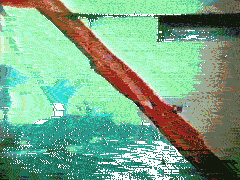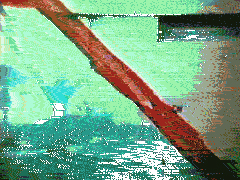Part of Winter 1991
Dirk de Bruyn is a Dutch born film and videomaker now living in Australia. De Bruyn’s work is marked by an exploration of inexpensive techniques and their use in creating abstract, vibrant works. Among the techniques employed de Bruyn are bleach, artist’s glue, spray on glue, a hole punch, stick on shapes, fabric dyes, scratching, permanent felt pens, letraset, home processing and tape splices. There is a layering of elements which becomes more complex and controlled with each film. The screen is overwhelmed with movement, colour and motion. The resulting effect is abstract, rhythmic, intricate works.
Feyers 29 min, 1989.
Feyers is de Bruyn’s most complicated work employing the many techniques he has experimented with over the years. Appropriately subtitled ‘a dance’, this film’s interweaving of various experimentations lends itself to a stunning, rhythmic effect. “Colour, vision, excitement, breathless activity all collide here to create a cacophonous poetic.” (Janice Filipuzzi, Modern Image Makers Association)
Boerdery 11 min, 1984
Boerdery is an excerpt from de Bruyn’s feature length film Homecomings about his return to Holland after a 25 year absence.
“All of the Netherlands is a landscape produced by a culture (the dykes, dams, and reclaimed land). The space of the landscape and house is used as a source of meditation back to childhood, and forms of filmic meditation and trance are employed to enhance this staring. The time lapse images are also meant to suggest a staring into time, a looking at an idealized past that has been passed down to us through old photographs of us with our parents. The diary form of filmmaking can be used to break down narrative structure. It suggests an open structure. In a diary you have splatters of ideas, trains of thought, rather than a story as such with an underlying current of self. This is more human.”
223 5 min, 1985.
223’s photographs, which were the starting point for that film, are from the Homecomings film, and have had all sorts of processes turn them to abstraction. School photos and a house that my father bricklayed are the contemplative images in the film. ‘223’ alludes to time and by coincidence was a number that appeared on a letraset sheet.”
Knots 11 min, 1989
The roving eye in the crowd. Flickering sunlight. Fast forward. B4 it was seeing faint movement on the distant horizon. Now the skill is to see the rush from the passing car. We are on the run. Visual experiences that cement out daily lives, with an increasing uneasy disjointedness. Images like afterthoughts. Flows. Standing waves. Kill kill the eye. Fade the past. Fun the film like water through the eye. Rush ruse use muse. The language of the flash now. Curtains twisting and folding. Images tying around each other: distant memory. (Text from Knots).
Light Play 8 min, 1984 & Vision 3 min 1984.
Light Play and Vision are the second and third films in a series exploring frameless film and direct-on-film techniques.
“In Light Play the rhythms of the images hang on the music soundtrack (by Michael Luck). Abstract images dance round the screen and are at times tied to ‘real’ photographic images. I have also developed positive/negative techniques that repeat some of the abstract shapes in negative. Light Play, because the film is a play with light and was hard work.”
“Vision concentrates on squares and lines and geometric patterns. Letratone, bleaching, drawings with felt pens, etc. are used to propagate the abstract shapes. Shapes are repeated through refilming and negative images a la Mondrian. Vision was just a title which I had made for an unknown film that I had hanging in the room where I did all my work.”

